
博多 い津み
Hakataizumi ◆ はかた いずみ
3.37
Hakata
「Fugu (Blowfish)」
40,000-49,999円
--
Opening hours: 17:00-22:00(O.S.20:30)
Rest time: Sundays Business hours and holidays are subject to change, so please check with the store before visiting.
福岡県福岡市博多区住吉2-20-14 スパイラルステップス
Photos
(20)



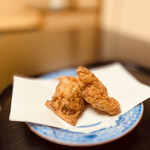
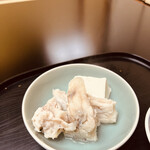













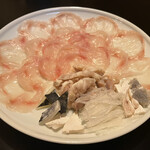

Details
Reservation Info
can be reserved
Payment Method
Credit cards accepted
(VISA, Master, JCB, AMEX, Diners)
Electronic money is not accepted.
Private Dining Rooms
having
Smoking and Non-Smoking
No smoking at the table
Parking
None
Facilities
Calm space, tatami room available
Drink
Sake available
Comments
(21)
食べking
4.20
Established in 1923, this renowned restaurant is known for its exquisite Fukuoka cuisine. As soon as you step in, you are greeted by staff in traditional attire and guided to a private room. The female owner personally welcomes you, setting the tone for a delightful dining experience. The meal begins with a beautiful simmered dish, followed by a highlight - premium pink-fleshed fugu sashimi, a rare delicacy that requires advance booking. Squeezing orange and sprinkling rock salt on the sashimi enhances its flavor. The meal continues with a generous serving of fugu shirako, crispy fried fugu, and a comforting hot pot. The finale is a large strawberry dessert. Each dish is a delight, leaving you fully satisfied. This restaurant is truly a place of bliss, best experienced rather than described.




BbW
3.50
This is the biggest blowfish I've ever had. It's satisfying and delicious! They also have blowfish tempura, and a full blowfish course meal. I forgot to take a picture, but blowfish goes best with fin sake! It's not a place I can visit regularly, but I'd like to come back again. Thank you for the meal!


口福ヤマトモ
5.00
●I visited the restaurant multiple times and was impressed by the quality of the ingredients and dishes even when I had the farmed fugu course during a gathering in January. Due to the pandemic, I hadn't been able to go for a while, but I wanted to enjoy fugu as before, so I made a reservation for the "Special Natural Fugu Course" in advance and visited. Just a heads up, this course does not come with shirako, so if you want shirako, you need to reserve it separately. I once had the opportunity to compare the special natural, farmed, and cultured fugu here, and the flavors were completely different. Since then, I have made it a point to reserve the special natural fugu course for my personal visits here once a year as a luxurious treat. However, it's not guaranteed that the special natural fugu will always be available, and if the fugu does not meet the criteria for special selection, it becomes the "Natural Fugu Course" with a lower price. This time, I was informed the day before that the special course was not available, but we decided to visit as planned with three people. The special fugu is characterized by a candy-colored flesh (slightly pink without aging) or a pinkish color, so I was surprised when I saw the sashimi. Even though it was not a special selection, the individual had a slight pink color (other people's sashimi had a stronger pink color), which was surprising. When I asked the landlady, she explained that it couldn't be selected as special due to being slightly smaller in size, but it was quite close to being special. First, the simmered kogori had an incredible fugu broth coming out, and it was a wonderful dish where you could see the whole fugu in just this one dish. The fugu sashimi, which was not a special selection, was of such high quality that it was hard to believe. Even when eaten as sashimi alone, the umami flavor was strong, and it was further enhanced when eaten with salt (using British crystal salt). The ponzu sauce was a blend of several citrus fruits and genuine soy sauce, which was crisp and brought out the umami of the fugu. The skin and liver were also delicious. I ordered the shirako as an addition, calculating that the balance of the shirako flesh was just right at this time. With a firm membrane, it was a bomb of umami flavor. The fugu tempura was excellent because the quality of the fugu was good, with a firm flesh that matched well with the crispy coating. The fugu chiri was prepared in a separate room as it was a private room, and you could enjoy the wonderful taste of the fugu flesh here as well. The tofu was also of excellent quality, and vegetables such as Chinese cabbage and others became even sweeter and more delicious by soaking up the fugu broth. Finally, we finished with a porridge. This porridge is made by adding raw rice to the fugu broth, so the umami flavor permeates to the core, making it the best. Please check out the glossy presence of this rice. It's a taste that you would want to keep eating forever. We wrapped up with strawberries. Among the many fugu specialty restaurants from the Chugoku region to Hiroshima, Shimonoseki, and Oita, I think that Hakata Itsu-mi is the top restaurant in western Japan in terms of the quality of fugu and the level of cooking. To those who say "Fugu has no taste, it's the taste of ponzu sauce" or "Fugu has a taste of no taste," I would like to offer them a taste of real fugu and ask them again, "Are you eating real fugu?"
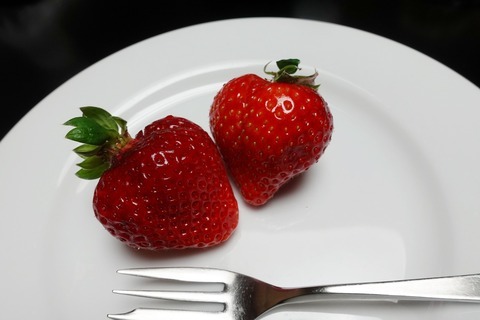



Prince of Wine (ワイン王子)
3.50
The prince has left the capital and arrived in Fukuoka. Tonight, he dined at the Michelin-starred blowfish restaurant "Hakata Itsuki". Blowfish and wine. This collaboration should definitely be chosen as one of Japan's top 10 food pairings. The first simmered blowfish was shockingly delicious! The blowfish milt was also melt-in-your-mouth delicious. There may not be a wide selection of wines, but they have a solid collection, so please enjoy it with white wine. The prince also chose white wine, and he had a wonderful experience. Thank you very much.




魚太
4.00
I was taken to this restaurant by a colleague in January. When it comes to fugu cuisine in Fukuoka, this is the place to go. Oh, I had the most amazing fugu dishes. The fugu sashimi was so flavorful and it was my first time trying it. The fugu milt was also so creamy, I wanted to eat more. I forgot to take pictures of the fugu tempura and fugu hot pot, but the tempura had a crispy coating and was delicious. I remembered the fugu tempura I had at Kisuitei before. The fugu hot pot and porridge were also delicious. Thank you for the wonderful meal.




mojosuke0448
3.40
I visited this restaurant with a meal voucher I received through a friend. I never expected to come here for a private meal and was truly impressed. Although I knew about it, I couldn't visit before due to the location and price. Upon entering the first floor of the historic hotel and climbing the stairs to the second floor, I was surprised to find a private room. I appreciated the consideration for COVID-19. As I started my meal, the proprietress came to greet us personally. She shared her passion for exploring new possibilities for blowfish by collaborating with master chefs in Chinese, Italian, and Japanese cuisine. She recommended blowfish fin sake, which was truly amazing. The flavor remained consistent even after multiple sips, a delight for sake lovers. Next, the young proprietress explained the blowfish sashimi preparation method. Apparently, they age the blowfish after marinating it in kombu before serving, which enhances the flavor. I could definitely taste the richness. Unlike the thinly sliced blowfish sashimi at some blowfish specialty restaurants, I could truly appreciate the deliciousness of this dish. The blowfish tempura had a chicken-like texture and deliciousness, truly outstanding. Although the hot pot was already portioned out, I missed the experience of enjoying it from the pot. However, it was convenient to have it served that way. I wanted to order blowfish milt as an extra, but to my surprise, it required a reservation in advance, leaving me feeling unsatisfied. I will definitely make a reservation for the milt next time!!! The hospitality of the proprietress and the young proprietress as they visited each room was truly heartwarming, reminiscent of traditional hospitality at its best.
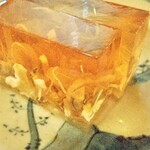



オリーブleaf
4.30
I celebrated a personal occasion by visiting the top fugu restaurant in Hakata, "Itsumi," with three friends. This was my second visit. The course meal was the most expensive one at 30,000 yen per person, but it was worth it for the top-notch food and service at Itsumi. The clear and elastic simmered dish served at the beginning was stunning and set high expectations for the rest of the meal. We also added the recommended grilled fugu milt, which was creamy and delicious. The highlight was the thickly sliced fugu sashimi, which showcased the sweet and savory flavors of the fish. The fried fugu was also delicious and not too heavy. The hot pot was light and refreshing, and we finished with a melon dessert. Despite the high price, I would love to visit this wonderful restaurant again. The attentive service and excellent food made for a fantastic celebration!




ピラ子
3.50
I have been requesting for a chair to be provided for taking off my boots in the entranceway, going up the stairs to the second floor, for the past 10 years. However, this year, I ended up sitting in a dirty area, causing my coat and dress to get dirty. I had requested a room that I liked, but without any notice, it was changed to a small, dark room. I had previously refused this due to feeling uncomfortable. When I clapped my hands from the room, no one came. It felt disappointing as the atmosphere was ruined. The sake and whitefish sake I had in the dark, cramped hidden room were delicious. Despite repeatedly asking for improvement, it remains unclear when it will be done. The disappointment of the experience does not match the price.




すし和食探究中
3.80
The final night of my business trip to Hakata, of course, had to be this. When in Hakata, you can't miss out on having blowfish. So, I made a reservation at the restaurant called "Itsumi" and ordered the natural tiger blowfish course. It seems that natural blowfish needs to be caught on the day to be served, and luckily, they had some today. Since this trip also coincided with my wife's birthday and our 30th wedding anniversary, I decided to go all out and booked a private room. We started with a half bottle of champagne for a toast. The meal began with a blowfish stew as an appetizer. It was much firmer and chewier than what I usually eat, with a rich flavor. Next was thinly sliced blowfish sashimi, a specialty of this restaurant, sliced "two sheets." This way, when you eat it, the meat goes into your mouth more easily, allowing you to fully enjoy the taste without being overpowered by the ponzu sauce. In simple terms, it was a sashimi with a satisfying texture. The sashimi was served with homemade ponzu sauce or vinegar with salt and citrus. At this point, a waitress came over and asked, "Would you like to try the blowfish milt?" It was a tempting offer that I couldn't resist. I had blowfish milt sashimi at Ginza Kojyu a week ago, so this time, I ordered grilled blowfish milt. When eaten with citrus and salt, the crispy outer layer combined with the creamy sweetness inside was truly exquisite. Moving on with the course, we had blowfish tempura. I have always believed that blowfish tempura is the most delicious blowfish dish. The natural tiger blowfish tempura had a firm and bouncy texture that was quite different from what I had eaten before, but it was undeniably delicious. Following that was a hot pot. Instead of serving the whole pot, the restaurant elegantly portioned it out into individual bowls. The hot pot included three different pieces of blowfish meat, tofu, Chinese cabbage, chrysanthemum greens, and rice cakes. The blowfish meat, as well as the tofu and vegetables soaked in blowfish broth, were incredibly tasty. I couldn't resist ordering some fin sake to accompany the hot pot. It paired perfectly with all the flavors in the pot. The finale was blowfish porridge, cooked from raw rice. And the egg used only the egg white, which was a detail I admired. It had been over 20 years since I last had blowfish porridge. I couldn't help but add some ponzu sauce to enhance the flavor. For dessert, we had two large Amaou strawberries. They were so big that I was worried if I could finish both, but in the end, both disappeared in a flash. And with that, the meal was over! Oh, it was my first time having natural tiger blowfish in a long while, and it was truly delicious. Thank you for the feast. Now, I have to get back to work tomorrow and give it my all! 💪




ジョニー72
3.00
I visited "Hakata Itsu-mi," a restaurant I had always wanted to try. It is a representative ryotei in Hakata where you can enjoy delicious blowfish dishes. We started with a toast of beer and sake with blowfish fins. The food started with simmered blowfish. The blowfish sashimi was truly delicious. You can try various parts of the blowfish. The blowfish milt was creamy and the citrus juice added a nice touch. The deep-fried blowfish was exquisite. The blowfish hot pot was prepared at the next table and served to us. It was elegant. Lastly, we had a refined blowfish porridge. It was a meal where we could truly savor the blowfish. I thoroughly enjoyed my blowfish experience at "Hakata Itsu-mi."




③オバタ
3.00
I visited this place to eat blowfish on this day. I had the option to choose between farmed blowfish and wild blowfish, but I decided to be cheap and went with the farmed one haha. The blowfish was served in a generous portion, so I didn't have to worry about eating like a lord haha. It felt like a very farmed blowfish though. After enjoying the typical blowfish dishes, it was time to say thank you for the meal. I think I prefer eating blowfish as a side dish in a kaiseki meal rather than eating a large amount like this. I ended up feeling sick after eating so much blowfish. Thank you for the meal.




Mrびーん
4.50
The specially selected natural tiger puffer sashimi is a supreme dish that you may encounter if you are lucky! The moment you eat it with carefully chosen natural salt and citrus, you will be reminded of the deadly "heel drop" move! It's a guaranteed knockout!




macosharedaisuki
4.00
This restaurant serves delicious blowfish dishes. It offers authentic blowfish cuisine, which can be enjoyed in various ways. I was really impressed.




3103七里
2.40
It was delicious, but it was disappointing that there was no tetchiri in the course. Shirako is only available in autumn and winter, so if you want to eat fugu, it's better to do so in autumn or winter. At this price, I think I would be more satisfied with sushi.




戸田 としえ
4.50
I enjoyed a deluxe course meal with shirako (milt) and grilled blowfish at this restaurant!


はまちゃんポルコ
4.10
It was very elegant and delicious. That blowfish is not easy to come by.
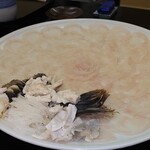
beat2555
3.00
One-star blowfish restaurant in Hakata, with typical pale blue plain dishes, unremarkable food, the porridge is made from rice at the table, so it takes about 25 minutes, but there is no unpleasant smell of steamed rice, so no egg is added, as explained by the staff. Therefore, the taste of the porridge was good.
ピラ子
3.50




acoso
0.00




kacchan_1
4.00
I went while being cautious about COVID-19, but it was delicious.
alts_1999
3.80
I love the unique thickly sliced beef tongue for its taste and texture. The atmosphere is great and the service is really attentive and pleasant.
Email Login